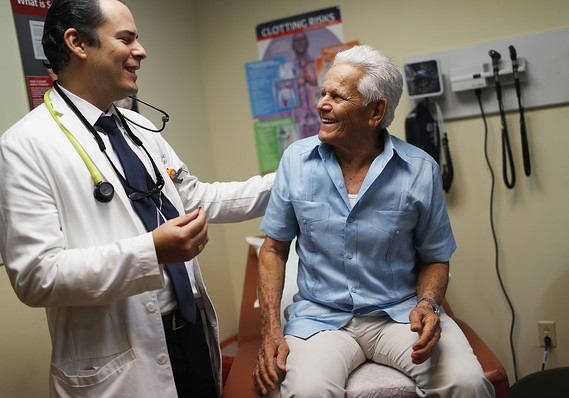 Getty Images
Getty Images
Has your primary-care physician closed up shop? It’s happening all over the country.
Walgreens WBA, +1.49% announced last month that it will start operating primary-care physician services at some of its stores. They will operate differently from traditional walk-in care facilities at pharmacies where people typically go when they have an immediate health problem.
The offices will be 2,500 square feet, and have a separate entrance, plus connecting doors to Walgreens. Patients (and Walgreens customers) can go there for their annual check-up and get referrals for specialists, just like they would do at the family doctor.
They will initially be available at five stores in Houston. The primary-care offices will be provided by Walgreens in partnership with VillageMD, a national provider of primary care. The doctors at these locations in Houston will work with nurses, social workers and Walgreens pharmacists.
An increasing number of employer-sponsored health insurance enables people to go directly to a specialist.
The move is an attempt to address the decline in primary-care doctors. Patients are looking for more high quality primary care, said Patrick Carroll, Walgreens’ chief medical officer. He said both companies want to create “neighborhood health destinations.”
Office visits to primary-care physicians, doctors who often have an intimate knowledge of their patient’s history, declined 18% over a four-year period for adults under 65, according to the Health Care Cost Institute. Office visits to nurse practitioners and physician assistants spiked 129%.
Here are some reasons primary-care physicians are shutting up shop:
1. An increasing number of employer-sponsored health insurance enable people to go directly to a specialist and avoid paying extra for a primary-care physician. But the dramatic increase in visits to nurse practitioners and physician assistants did not result in cost savings, the institute said.
2. There’s also more financial incentive to avoid the traditional vocation as a family doctor. Orthopedic surgeons make between $374,550 and $616,360 a year, according to Salary.com, while primary-care physicians make between $177,370 and $231,107.
Don’t miss: For the first time, physicians are less likely to operate their own practices
3. Primary-care physicians face additional time and expense managing their practice, and often have a fluctuating income. Doctors who leave medical school with a large amount of student debt may also prefer the stable income of a job in a hospital, with the prospect of advancement.
4. More doctors with financially successful practices in areas with more high-income patients are transitioning to a concierge service to help cover their rent and other costs. Those who can’t afford that may end up going to urgent care facilities or traveling farther to a new primary-care doctor.
5. The average student-loan debt for four years of medical school, undergraduate studies and higher education was $196,520 last year, up from $190,694 in 2017, according to the Association of American Medical Colleges. (It was even higher for dental school: $287,331.)
Still, young doctors are under pressure to earn big bucks. “With a $197,000 student-loan balance, you would owe $2,212 a month on the standard, 10-year federal repayment plan, assuming a 6.25% average interest rate,” according to a calculation by the personal-finance site NerdWallet.
Patients will ultimately pay a price. The Association of American Medical Colleges forecasts a primary-care shortage of between 14,800 and 49,300 doctors by 2030, according to a 2018 report in Modern Healthcare, an online publisher of health-care news and analysis.
There’s persistent payment disparities between primary care and procedural specialties in the health-care system.
There’s also more risk of “primary-care deserts.” From 2005 to 2015, the density of primary-care physicians actually fell to 41.4 per 100,000 people from 46.6, researchers at Stanford University found in a recent study published in the peer-reviewed medical journal JAMA.
That could have long-term effects for patients: 10 additional primary-care physicians per 100,000 people was associated with a 51.5-day increase in life expectancy, it added. It analyzed data from 3,142 counties, 7,144 primary-care service areas, and 306 hospital referral regions.
“Many believe that a well-functioning health care system requires a solid foundation of primary care. However, persistent payment disparities between primary care and procedural specialties continue to erode the U.S. primary care physician workforce,” the Stanford University study found.
Approximately 65 million people live in “a primary-care desert,” according to the physician-search firm Merritt Hawkins. Those who live far away from a primary-care physician will suffer the most. Ultimately, they may end up ignoring symptoms to serious, even life-threatening, problems.
Get a daily roundup of the top reads in personal finance delivered to your inbox. Subscribe to MarketWatch’s free Personal Finance Daily newsletter. Sign up here.





